With the 2018 National Hockey League Entry Draft fast approaching, teams around the league are putting the finishing touches on their draft lists, if they haven’t finalised them already.
The Florida Panthers’ contingent, led by general manager Dale Tallon, are in a tricky drafting position. Selecting 15th overall, the Panthers have an opportunity to snag a quality player that will play in the NHL for a long, long time
That said, there are very few slam dunks in hockey, and almost none outside the top three to five selections. Thus, picking 15th overall is no guarantee of a good – or even serviceable – player. Funnily enough, the 15th spot in particular has been, as TSN’s Scott Cullen describes it, a “wasteland.”
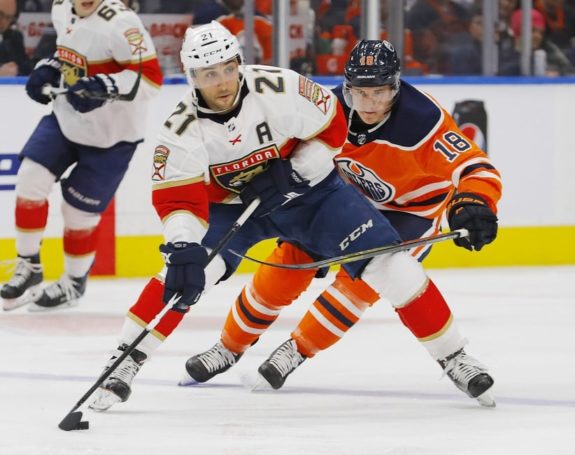
Statistical oddities aside, it’s tough to know what to expect from draft picks. However, it’s somewhat easier to generate expectations for team behaviour, given the possibilities afforded by post-hoc analysis.
Thus, without further ado, here are the Panthers’ draft tendencies since 2010, the year Tallon first came on board as GM. It should be noted Tallon was not the GM at the time of the 2016 draft, as he was – briefly – moved to the president of hockey operations position, and long-time top scout Scott Luce was let go altogether.
Panthers’ Draft Tendencies Since 2010
The following analysis will compare the Panthers’ draft work to that of the rest of the NHL between the 2010 and 2017 drafts, inclusive.
Whether the conclusions will prove predictive of the Cats’ draft strategy in 2018 remains to be seen. Still, there are some decidedly interesting trends amongst the 62 picks Florida has made these past eight drafts.
Panthers Draft Picks and Average Size
Interestingly (or not, depending on your perspective), the Panthers have selected a group of players all but identical in height and weight to the average of the rest of the NHL. The average height of a Panthers draft choice has been 5-foot-11, with an average weight of 188 pounds, exactly the same as the average of the selections of the rest of the NHL, save for a decimal here and there.
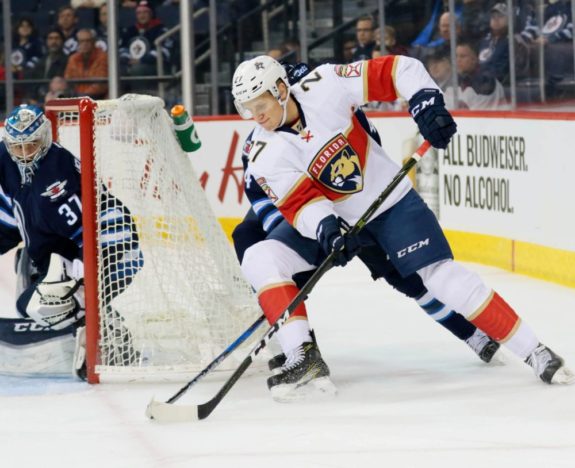
Obviously, teams have some say in the post-draft development of their prospects, with a team of professionals able to advise players on developing the weight and musculature best suited to maximise their potential.
However, it’s simply remarkable how perfectly the stature of Florida’s draft choices mimic those of the rest of the NHL at the time of their selection.
Panthers Draft Picks and Country of Origin
The ever-increasing diversity of the NHL has led scouts into parts previously unknown to scoop up promising talent. However, the vast, vast majority of NHL players still come from only five countries; just over 90 percent of the league was born in Canada, Finland, Russia, Sweden or the United States.
The Panthers’ distribution is even more extreme, with 61 of 62 – over 98% – of their draft picks having come from said five countries, with a lone Swiss national (Denis Malgin, Fourth Round, 2015) rounding out the set. 62 picks isn’t a terribly large sample size, but it’s still noteworthy that all 62 have come from just six total countries.
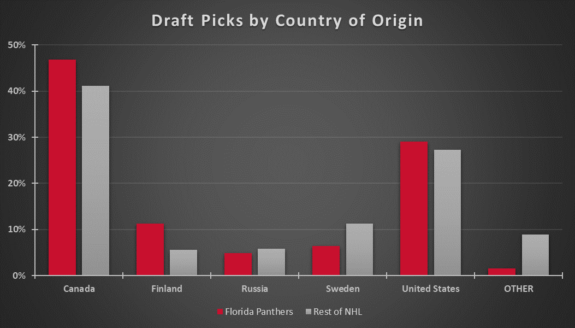
As you can see, the Panthers have drawn more heavily from Canada and the United Sates than the rest of the NHL, and have taken twice the number of Finns as Swedes, while the rest of the league does the opposite.
This last point is particularly interesting, given that Sweden is a country with nearly twice the population of Finland, and has produced a roughly corresponding number of active NHLers as opposed to their neighbours.
It’s worth noting the Panthers’ director of European amateur scouting is Jari Kekalainen, brother of Jarmo (GM of the Columbus Blue Jackets) and Janne (a European scout for the Nashville Predators).
As you might guess by the last name, Kekalainen is Finnish and is based in Helsinki, so perhaps the Panthers feel they’ve got a better line on Finnish talent than the rest of the league.
For example, they selected Henrik Borgstrom 23rd overall in 2016, while the highest I found him ranked was 35th (TSN’s draft board). If his college performance is anything to go by, maybe they’re on to something. Another bold, though somewhat less-surprising call was picking Aleksander Barkov in 2013.
Panthers Draft Picks and League of Origin
Now, obviously, nationality shouldn’t factor into draft selections much, if at all.
However, a player’s league of origin is indeed worthy of scrutiny and the Panthers have generated some interesting draft trends with regards to the leagues they select from.
Most notably, the Cats have drafted fewer than half the proportion of players from the Western Hockey League as their peers, while selecting high-schoolers nearly twice as often. Additionally, the nationality differences mentioned earlier persist in the analysis of leagues of origin, with Finnish leagues being drawn upon heavily, while Swedish circuits have been comparatively underutilised.
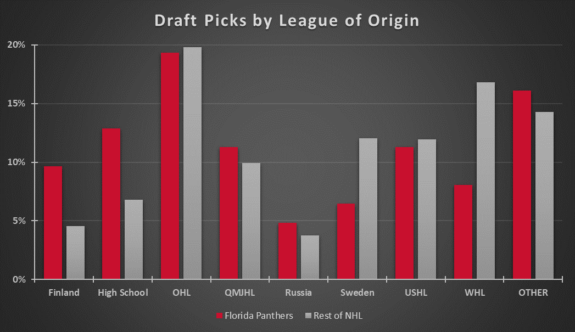
The WHL finding is especially curious, given the Panthers’ stated desire to put defense first; the WHL is generally regarded as a tougher, more defensive-minded league as compared to its fellow Canadian major junior circuits, the Ontario Hockey League and Québec Major Junior Hockey League.
Panthers’ Drafting, Development Paying Mixed Dividends
Scouting and, ultimately, selecting players in the draft is a decidedly inexact science. What follows is yet more uncertainty, with player development, roster construction and organisational changes all adding layers of complexity to the already herculean task of building and maintaining a pipeline of NHL talent.
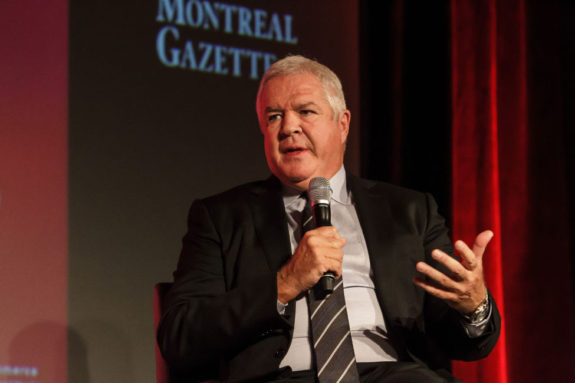
The Panthers are the perfect embodiment of this notion for, though they seem to be relatively competent in drafting, their on-ice record since 2010 has been decidedly dismal. Florida ranks 26th in team points percentage since 2010-11 (.514), with a record of 276-259-87 in 622 games and just two playoff appearances – both first-round exits.
Panthers Select Promising Players
However, with regards to player selection specifically, Tallon and his team seem to have done rather well since his arrival in South Florida. Since 2010, 12 Panthers draft picks have played 100 or more games in the NHL, tied for second in the league behind the Anaheim Ducks, who have 14 to their credit.
That said, only three Panthers selections have done so since 2011. Additionally, of the 12 players with 100 or more games played, three never even played a game with the Panthers due to the club being unable to sign them. With Adam Mascherin (Second Round, 2016) opting to go back in the draft, there is, potentially, a fourth member of said list in the works.
4th time in 6 years Tallon hasn't been able to sign a prospect. Team has lost donskoi, hyman, pakarinen, and now mascherin because of it. unreal. is that a record? https://t.co/NeareDhCWr
— Jason Botchford (@botchford) June 1, 2018
2018 NHL Draft Fast Approaching
The 2018 draft will be held Jun. 22-23 in Dallas. As of right now, the Panthers will be selecting from the middle of the pack, but there is still ample time for them to move up, presumably to take a player they rate highly that may not be available at 15. They might also move down, trading the 15th pick for two or more picks later on, or as part of a roster-player transaction with another team.
Whatever the case, the Panthers’ drafting has been noticeably different from the rest of the NHL over the past eight years. It’ll be interesting to see if that trend continues.